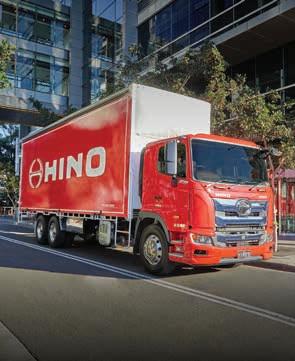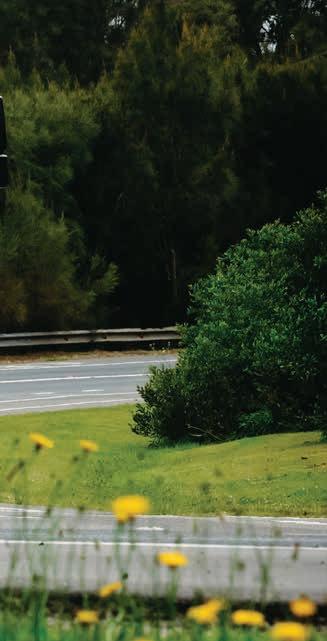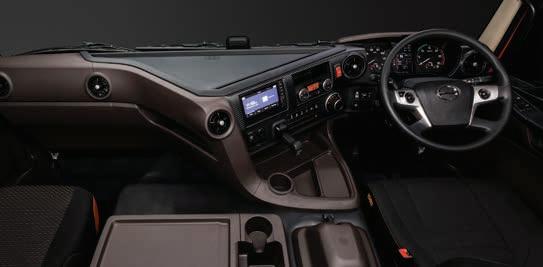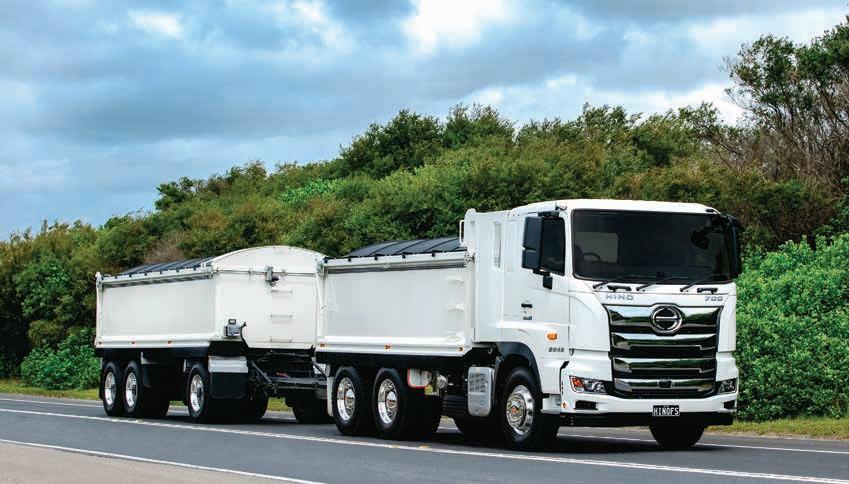
13 minute read
NO MANUAL INCLUDED
Road Test
HINO HAS LIFTED THE GAME WITH ITS NEW FLAGSHIP 700 SERIES MODELS, OFFERING MORE REFINEMENT, BETTER SAFETY AND PERFORMANCE, REVISED ENGINES AND AS A MARK OF THE TIME, ONLY AN AUTOMATIC OR AMT WHEN IT COMES TO TRANSMISSIONS, WITH NOT A GEAR STICK TO BE FOUND, WHICH IS NO BAD THING. WE HAD A DRIVE IN TWO VERSIONS OF THE 700 AND FOUND THE NEW HINO HEAVY TO BE A VERY GOOD TRUCK.

The rain was bucketing down as we headed south from Sydney along the M6 Motorway during the ‘Big November Wet’ . This is a notorious piece of road that often finds itself suddenly bathed in thick fog and the combination of the heavy rain and foggy conditions made the going absolutely treacherous.
We were at the wheel of Hino’s latest 700 Series, which due to Covid, had been launched ‘virtually’. We were now having our first drive of the new Hino Heavy Duty, the flagship of the Hino fleet.
The particular vehicle we found ourselves piloting through the mist, was the 700 FS2848, configured as a Tipper Dog and with the latest Hino 13 litre 480 hp engine mated to the ZF Traxxon 16 speed AMT. As the nomenclature reveals the 2848 refers to the fact that the truck has a 28 tonne GVM and the engine is rated at 480hp.
On a day of incessant rain we were taking things carefully, splashing through the puddles as we tacked our way south from the Hino HQ towards Wollongong. It had been a number of years since we had taken a truck down the challenging Mount Ousley, a descent that is challenging for any truck, not to mention climbing back up it on the return run.
As we said the fog, rain and mist on the M6 was a challenge but ensconced in the Hino cabin, we were at least dry, warm and cocooned away from the nasty weather outside.
Inside the cab is one area that has had the wand waved over it and with, what seems to be Hino’s new trademark, a stylish ochre brown interior, which we first saw in the 500 Series. It is a real change from the boring greys and blacks that normally pervade the cabs of Japanese trucks, in fact the cabs of trucks of any nationality.
The cockpit has been has been transformed with not just the colour but the wrap around design and the carbon fibre look finish to the instrument surrounds and central console.
The dash is very simple and extremely well laid out. There are minimal switches and the instruments are large and easy to read with the right amount of information. More automotive designers need to take a look at the Hino dash, because increasingly they either forget or overlook the fact that the driver is usually rolling down the road at around 100 km/h or 26 metres per second, and the more complex the dash and controls the more likely focus will be taken off the road and the hazards ahead. It’s not rocket science, and that’s the point, in a rocket in space you could take your eyes off the ‘road’ to attend to complex switches and instruments, you simply can’t in a truck on a busy road at 100km/h.
While the new Hino 700 looks a lot like the old one it replaces, under the skin it is a very different truck with all new interior structures and exterior panels. Hino says it was necessary to give longer rearward travel for the driver’s seat but also to give a 15mm lower hip point for the driver, with the former benefiting taller pilots and the later helping shorter ones.
The new cab design, allowed for the latest gen electronic architecture to fit, thanks partly to a new dash, which has given more room for componentry.
That has enabled Hino to expand its SmartSafe suite which has already found favour with customers in the brand’s 300 and 500 series models.
The safety features include pre-collision system with autonomous emergency braking, pedestrian detection, lane departure warning system and vehicle stability control.
The 700 also includes such things as the new Driver Monitor camera, which is positioned in the moulding on the A-pillar. This system is designed to detect driver fatigue by scanning the eye and head movement and will warn if the driver looks to be dozing or at the very least displaying inattention.
The Driver Monitor is also integrated with the Lane Departure warning giving the driver a warning if the system detects the truck is wandering within the lane.
As we splashed our way South, the Hino heavy was impressing with not only its new cab but also the way it was responding and tracking in the rugged conditions. It was so wet and miserable that it was virtually impossible to take photos of the truck, which is why pics of the tipper dog unit in this story are on dry roads, they were taken a week or so after our test.
The test we really wanted to throw at this 26 tonne unit was the Mt Ousley descent. Engaging the retarder with the wand on the steering column gives an impressive amount of slowing power, and we used a Kenworth with a single trailer in front of us as a guide. The Kenny driver was constantly on and off the brakes, trying to drag it back to a manageable and legal pace. In the Hino however, we

were comfortable retarding our progress using only the wand, moving it between the levels to slow it up or to let it run. The Kenny appeared to be lightly loaded with not too much on the open trailer so both trucks were grossing similar weights.
It was extremely confidence building, and the more we used it the more confident we were in its ability to manage the speed of the Hino on steep downhill runs.
Once at the bottom the Hino was pointed toward Port Kemba, in an environment that is truck central. Plenty of similar tipper dog rigs and lots of B-Doubles and single semis, all battling the wet and slippery roads. The Hino tracked and steered very well and always felt well tied down and manageable.
Above all it was easy and comfortable to drive, with the 16-speed Traxxon AMT making the Hino a very user friendly truck. Couple that to all the safety systems and for fleet operators needing trucks at the bottom end of the heavy sector, this would be an ideal choice.
The Hino 13 litre is a nice, flexible and very driveable engine, which at 480hp is a little on the conservative side these days, with a lot of manufacturers, including notably Japanese rival Fuso, pushing their 13 litre units up past 500 hp. Speculation is that market leader Isuzu may have a 500 plus flagship in the not too distant future, but that is yet to be confirmed. Hino however has resisted pushing up and locked this engine in at a safe and happy 480 horses.
Just how good that engine and transmission package performed under heavy climbing, we were about to find out. Ahead lay the return ascent of Ousley, and we have to say the Hino held its own and impressed with its honest effort and the deep well of torque that allowed it to crest the top still holding ninth gear. It was a strong effort that underlined the fact that if Hino wanted to uprate the power on this engine it would not be too much of a struggle. Watch this space, we reckon a higher horsepower Hino may be on the horizon.
Back in Sydney’s southern outskirts the traffic and the stop-start at the various intersections, further tested the 13-litre driveline. All to soon we were back at Hino and parking the 13litre. We had a best average fuel burn of 2.5km/ litre which given the conditions and the number of heavy climbs and descents along with the weight we were hauling was a pretty good result.
We’d organised to step straight out of the 13-litre FS and into the new nine-litre 700 Series FR, using Hino’s superb newish sixcylinder that first debuted in the 500 Series about three years ago. It has since been further uprated to meet the equivalent of Euro 6 emissions
The FR test truck was specced as a heavy rigid tautliner and although the architecture and appearance, the systems and interior design are the same for the nine or 13-litre models, the new cab can



sit lower on the smaller nine litre. In fact around 120mm, which clearly means it is less of a climb up into the cockpit. This is an important aspect for drivers who are in and out of the cab all day, doing metro delivery runs, with the lower climb height making it a much easier truck to live with.
It is easy to identify the engine spec from the outside with the smaller engine 700s featuring a three-bar grille and the 13-litre versions having a four-bar grille.
The new cabs now have a four-point suspension system, which certainly is something that benefits the ride and overall NVH in the cab. We felt it and appreciated it in the 13-litre on our trip to the ‘Gong, and it was equally appreciated in our city work in the nine-litre.
With the lower entry on this truck also comes a better and safer climb up by staggered steps, on both models, while there is also a redesign of the front access flap to pre-check vital fluid reservoirs.
The nine-litre interior, apart from being closer to the ground is very similar to its big brother.
Like the bigger truck, there is a seveninch multifunction display that can be scrolled through to give a variety information to the driver, accessed by toggle switches on the steering wheel.
In fact the entire dash is easy to access and read and now that Hino no longer offers a manual trans in the 700, the designers did not have to grapple with where to place a gear stick. In the ninelitre, mated to an Allison six speed auto there is a touch pad control, while the 13-litre had a rotary dial on the dash to select gears.
In terms of creature comforts, all 700s come with climate control aircon/heating as standard, while there is a full-width bunk behind the seats that is enough for drivers to rest on, or to store baggage etc. but is not really designed for a comfortable night’s kip.
Fire the nine-litre up and there is very little vibration or rattle. This is a very sophisticated diesel, which when we first drove it in the wide cab 500 impressed us, and led us to say that it was the closest thing to a European engine we’d ever experienced in a Japanese truck. That was of course before Fuso put the 13 litre in its Shogun, but that is a European engine.
This truck was an FR 2632 6x2, which following the same nomenclature code indicates that it had a 26 tonne GVM with the 320hp version of the nine-litre. The truck had the standard wheelbase with a 14-pallet tautliner curtain-sider.
The Hino people had loaded it to 18 tonnes with a bunch of IBCs in the back.
With the engine purring in the background, we touched the Allison selector pad and moved away, negotiating the back streets of Taren Point on our way north, this time heading for a loop around the metro areas of Sydney. We were emulating the sort of conditions and work schedule that a truck of this spec would
normally tackle.
The rigid nine-litre was a lot more manoeuvrable than its tipper dog sibling and in and out of the traffic, with its flexible engine and efficient shifting auto, it proved a breeze to guide around the wet roads of the Southern suburbs.
In fact the big rigid was almost car like in its ease of operation and nimbleness. The shifts from the Allison were smooth, quick and well timed and it proved the perfect package for the sort of work this truck would be tasked with.
With the Allison programmed and mated to the Hino’s engine management computer the gearbox always seemed to have the truck in the ideal rev range in the ‘eco’ band from 900 to 1500 rpm.
Hino has given the 700’s a new braking system that melds with its new safety suite. There is now an Electronic braking system that provides a much faster signal to the modulators and sits alongside and compliments the fall-back pneumatic signal line. Disc brakes haven’t made it on to the agenda with Hino yet, but the 700 uses highly efficient tapered-roller drums and they work just fine.
The nine-litre’s 320hp is aided by its 1275Nm of torque which peaks between 1100 and 1600rpm and has a Jacobs brake as standard. It’s mated to Allison’s 3200, six-speed automatic torque converter transmission.
Underneath the rear of the rigid was a standard Hendrickson HAS rear tandem boasting adjustable dock-height settings, while Hino now fits cross axle diff locks as standard, selected by a switch on the dash, making it a handy way of avoiding being hung up on ramps and gutters, particularly when unladen.
ISRI suspension seats are now standard for drivers making the comfort factor in the Hino even better, with plenty of adjustment in both the seat and the steering column, while the seat belt is attached to the seat, making it a lot easier and comfortable to use.
Vision from the revised Hino cab is excellent, with good all round sight lines and a strong selection of mirrors and cameras to deliver the extra spatial awareness to the driver. The mirrors are electrically powered and heated covering every angle, while the cameras gave extra coverage to the sides and behind, with the display on the central seven inch infotainement screen in the middle of the dash.
With a Jake brake as standard, coupled with the six speed Allison, the FR also offered excellent retardation without the need to go for the service brakes. Like its big brother the Jake is activated by a wand on the steering column, but with just the one level not four like the ZF equipped retarder.
We all know how well the Jake works, and with the intuitive nature of the Allison in down shifting when needed, the whole package is excellent. This is further enhanced by the brake blending switch, which combines the Jake with the service brakes. With this selected pushing the brake pedal also automatically brings on the Jake to assist, it is very good.
A day and bit driving the rigid 700 FR around Sydney’s increasingly crowded and fraught roads showed us what a good truck this is for tackling this sort of work.
It is quiet, easy to use, safe and above all economical, with an average of just over 3 km per litre.
It’s little wonder that the Japanese brands dominate this sector, and with trucks like the new 700, using either the nine or the 13-litre engine, Hino is going to sell a lot more heavies, particularly with even more new variants on their way, and potentially a 500 plus hp version down the track, not to mention a hybrid model to come.
Hino and Fuso now have the best artillery on this battlefield, despite the fact that Isuzu has an advantage in territory and ascendency.
However the real winners in the technology and refinement race the three Japanese brands are fighting are truck buyers and in particular truck drivers. Life as a driver in a truck like the new Hino 700 would be very comfortable thank you very much and we’d gladly put our hand up to do just that in one of these.













